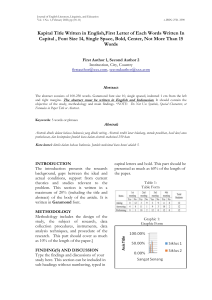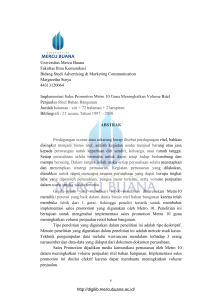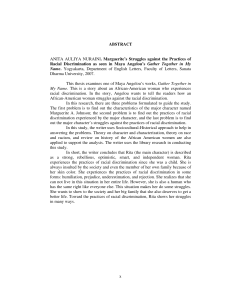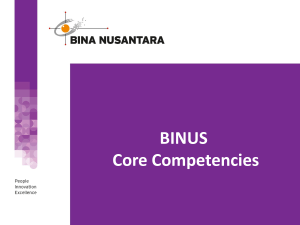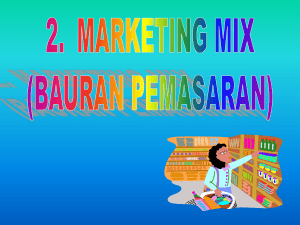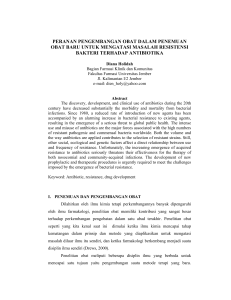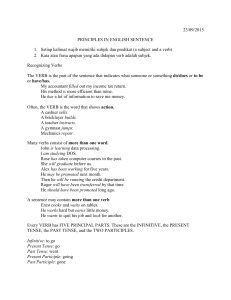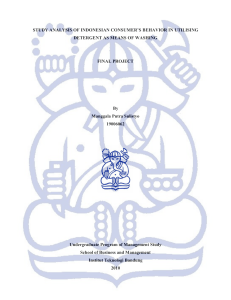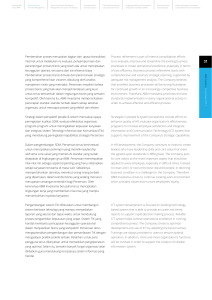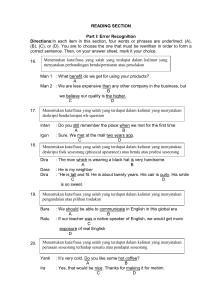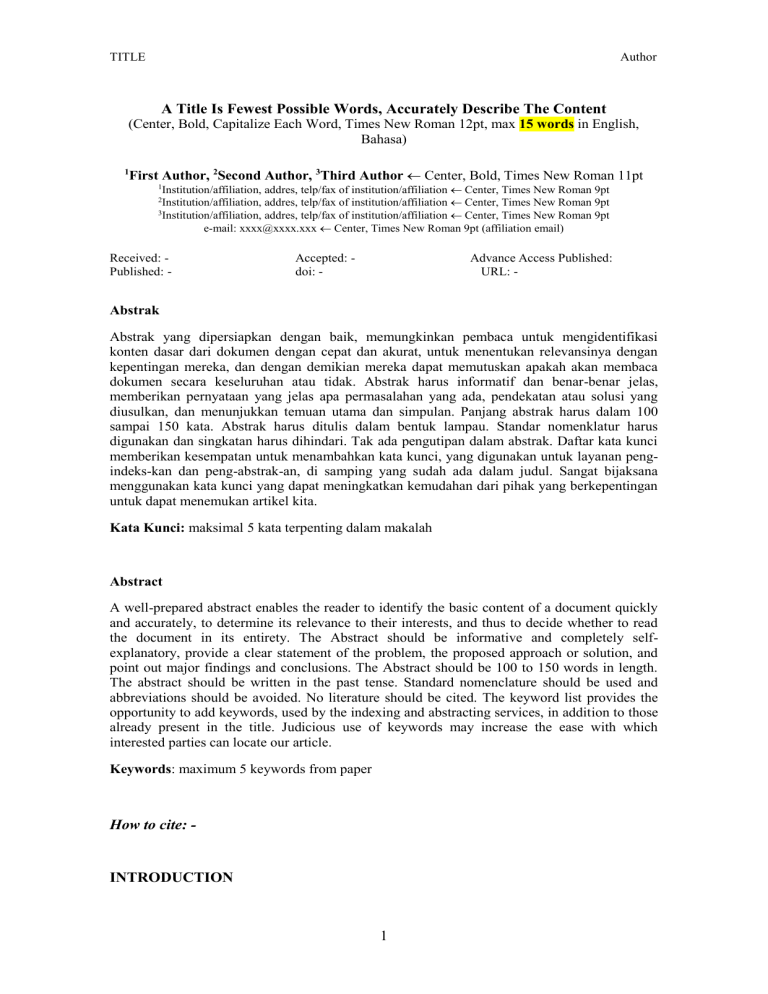
TITLE Author A Title Is Fewest Possible Words, Accurately Describe The Content (Center, Bold, Capitalize Each Word, Times New Roman 12pt, max 15 words in English, Bahasa) First Author, 2Second Author, 3Third Author Center, Bold, Times New Roman 11pt 1 addres, telp/fax of institution/affiliation Center, Times New Roman 9pt addres, telp/fax of institution/affiliation Center, Times New Roman 9pt 3Institution/affiliation, addres, telp/fax of institution/affiliation Center, Times New Roman 9pt e-mail: [email protected] Center, Times New Roman 9pt (affiliation email) 1Institution/affiliation, 2Institution/affiliation, Received: Published: - Accepted: doi: - Advance Access Published: URL: - Abstrak Abstrak yang dipersiapkan dengan baik, memungkinkan pembaca untuk mengidentifikasi konten dasar dari dokumen dengan cepat dan akurat, untuk menentukan relevansinya dengan kepentingan mereka, dan dengan demikian mereka dapat memutuskan apakah akan membaca dokumen secara keseluruhan atau tidak. Abstrak harus informatif dan benar-benar jelas, memberikan pernyataan yang jelas apa permasalahan yang ada, pendekatan atau solusi yang diusulkan, dan menunjukkan temuan utama dan simpulan. Panjang abstrak harus dalam 100 sampai 150 kata. Abstrak harus ditulis dalam bentuk lampau. Standar nomenklatur harus digunakan dan singkatan harus dihindari. Tak ada pengutipan dalam abstrak. Daftar kata kunci memberikan kesempatan untuk menambahkan kata kunci, yang digunakan untuk layanan pengindeks-kan dan peng-abstrak-an, di samping yang sudah ada dalam judul. Sangat bijaksana menggunakan kata kunci yang dapat meningkatkan kemudahan dari pihak yang berkepentingan untuk dapat menemukan artikel kita. Kata Kunci: maksimal 5 kata terpenting dalam makalah Abstract A well-prepared abstract enables the reader to identify the basic content of a document quickly and accurately, to determine its relevance to their interests, and thus to decide whether to read the document in its entirety. The Abstract should be informative and completely selfexplanatory, provide a clear statement of the problem, the proposed approach or solution, and point out major findings and conclusions. The Abstract should be 100 to 150 words in length. The abstract should be written in the past tense. Standard nomenclature should be used and abbreviations should be avoided. No literature should be cited. The keyword list provides the opportunity to add keywords, used by the indexing and abstracting services, in addition to those already present in the title. Judicious use of keywords may increase the ease with which interested parties can locate our article. Keywords: maximum 5 keywords from paper How to cite: - INTRODUCTION 1 ALFAZ (Vol.6 No.1 [Januari-Juni] 2018 ISSN: 2339-2882) This template is designed to assist Author in preparing manuscript; it is an exact representation of the format expected by the editor. To use this template, please just Save As this MS Word file to your document, then copy and paste your document here. To copy and paste the text to this template document, please use “Special Paste” and choose “Unformated Text”. All papers submitted to the journal should be written in good English. Authors for whom English is not their native language are encouraged to have their paper checked before submission for grammar and clarity. English language and copyediting services can be provided by: International Editing and Asia Editing. The work should not have been published or submitted for publication elsewhere. The official language of the manuscript to be published in Alfaz journal is Indonesian, Arabic, and English. In Introduction, Authors should state the objectives of the work at the end of introduction section. Before the objective, Authors should provide an adequate background, and very short literature survey in order to record the existing solutions/method, to show which is the best of previous researches, to show the main limitation of the previous researches, to show what do you hope to achieve (to solve the limitation), and to show the scientific merit or novelties of the paper. Avoid a detailed literature survey or a summary of the results. RESEARCH METHOD Materials and methods should make readers be able to reproduce the experiment. Provide sufficient detail to allow the work to be reproduced. Methods already published should be indicated by a reference: only relevant modifications should be described. Do not repeat the details of established methods. Identify Subsections It is both conventional and expedient to divide the Method section into labeled subsections. These usually include a section with descriptions of the participants or subjects and a section describing the procedures used in the study. The latter section often includes description of (a) any experimental manipulations or inter-ventions used and how they were delivered-for example, any mechanical apparatus used to deliver them; (b) sampling procedures and sample size and precision; (c) measurement approaches (including the psychometric properties of the instruments used); and (d) the research design. If the design of the study is complex or the stimuli require detailed description, additional subsections or subheadings to divide the subsections may be warranted to help readers find specific information. Include in these subsections the information essential to comprehend and replicate the study. Insufficient detail leaves the reader with questions; too much detail burdens the reader with irrelevant information. Consider using appendices and/or a supplemental website for more detailed information. Participant (Subject) Characteristics Appropriate identification of research participants is critical to the science and practice of psychology, particularly for generalizing the findings, making comparisons 2 TITLE Author across replications, and using the evidence in research syntheses and secondary data analyses. If humans participated in the study, report the eligibility and exclusion criteria, including any restrictions based on demographic characteristics. Research Design Specify the research design in the Method section. Were subjects placed into conditions that were manipulated, or were they observed naturalistically? If multiple conditions were created, how were participants assigned to conditions, through random assignment or some other selection mechanism? Was the study conducted as a between-subjects or a within-subject design? RESULT AND DISCUSSION Results should be clear and concise. The results should summarize (scientific) findings rather than providing data in great detail. Please highlight differences between your results or findings and the previous publications by other researchers. The discussion should explore the significance of the results of the work, not repeat them. A combined Results and Discussion section is often appropriate. Avoid extensive citations and discussion of published literature. In discussion, it is the most important section of your article. Here you get the chance to sell your data. Make the discussion corresponding to the results, but do not reiterate the results. Often should begin with a brief summary of the main scientific findings (not experimental results). The following components should be covered in discussion: How do your results relate to the original question or objectives outlined in the Introduction section (what)? Do you provide interpretation scientifically for each of your results or findings presented (why)? Are your results consistent with what other investigators have reported (what else)? Or are there any differences? After presenting the results, you are in a position to evaluate and interpret their implications, especially with respect to your original hypotheses. Here you will examine, interpret, and qualify the results and draw inferences and conclusions from them. Emphasize any theoretical or practical consequences of the results. (When the discussion is relatively brief and straightforward, some authors prefer to combine it with the Results section, creating a section called Results and Discussion.) Open the Discussion section with a clear statement of the support or nonsupport for your original hypotheses, distinguished by primary and secondary hypotheses. If hypotheses were not supported, offer post hoc explanations. Similarities and differences between your results and the work of others should be used to contextualize, confirm, and clarify your conclusions. Do not simply reformulate and repeat points already made; each new statement should contribute to your interpretation and to the reader's understanding of the problem. Your interpretation of the results should take into account (a) sources of potential bias and other threats to internal validity, (b) the imprecision of measures, (c) the overall number of tests or overlap among tests, (d) the effect sizes observed, and (e) 3 ALFAZ (Vol.6 No.1 [Januari-Juni] 2018 ISSN: 2339-2882) other limitations or weaknesses of the study. If an intervention is involved, discuss whether it was successful and the mechanism by which it was intended to work (causal pathways) and/or alternative mechanisms. Also, discuss barriers to implementing the intervention or manipulation as well as the fidelity with which the intervention or manip ulation was implemented in the study, that is, any differences between the manipulation as planned and as implemented. Acknowledge the limitations of your research, and address alternative explanations of the results. Discuss the generalizability, or external validity, of the findings. This critical analysis should take into account differences between the target population and the accessed sample. For interventions, discuss characteristics that make them more or less applicable to circumstances not included in the study, how and what outcomes were measured (relative to other measures that might have been used), the length of time to measurement (between the end of the intervention and the measurement of outcomes), incentives, compliance rates, and specific settings involved in the study as well as other contextual issues. End the Discussion section with a reasoned and justifiable commentary on the importance of your findings. This concluding section may be brief or extensive provided that it is tightly reasoned, self-contained, and not overstated. In this section, you might briefly return to a discussion of why the problem is important (as stated in the introduction); what larger issues, those that transcend the particulars of the subfield, might hinge on the findings; and what propositions are confirmed or disconfirmed by the extrapolation of these findings to such overarching issues. CONCLUSION Conclusions should answer the objectives of research. Tells how your work advances the field from the present state of knowledge. Without clear Conclusions, reviewers and readers will find it difficult to judge the work, and whether or not it merits publication in the journal. Do not repeat the Abstract, or just list experimental results. Provide a clear scientific justification for your work, and indicate possible applications and extensions. You should also suggest future experiments and/or point out those that are underway. FOOTNOTES AND REFERENCES Each citation must be included references by using footnotes. Please use Turabian Style 8th edition, for example: 1. Book (One author) a. Footnote: 1 Malcolm Gladwell, The Tipping Point: How Little Things Can Make a Big Difference (Boston: Little, Brown, 2000), 64-65. 2 Gladwell, Tipping Point, 71. b. References: Gladwell, Malcolm. The Tipping Point: How Little Things Can Make a Big Difference. Boston: Little, Brown, 2000. Two or more authors 4 TITLE Author a. Footnote 1 Peter Morey and Amina Yaqin, Framing Muslims: Stereotyping and Representation after 9/11 (Cambridge, MA: Harvard University Press, 2011), 52. 2 Morey and Yaqin, Framing Muslims, 60-61. b. References Morey, Peter, and Amina Yaqin. Framing Muslims: Stereotyping and Representation after 9/11. Cambridge, MA: Harvard University Press, 2011. 2. Journal article In a note, list the specific page numbers consulted, if any. In the bibliography, list the page range for the whole article. Article in a print journal a. Footnote 1 Alexandra Bogren, "Gender and Alcohol: The Swedish Press Debate," Journal of Gender Studies 20, no. 2 (June 2011): 156. 2 Bogren, "Gender and Alcohol," 157. b. References Bogren, Alexandra. "Gender and Alcohol: The Swedish Press Debate." Journal of Gender Studies 20, no. 2 (June 2011): 155-69. Article in an online journal For a journal article consulted online, include an access date and a URL. For articles that include a DOI, form the URL by appending the DOI to http://dx.doi.org/ rather than using the URL in your address bar. The DOI for the article in the Brown example below is 10.1086/660696. If you consulted the article in a library or commercial database, you may give the name of the database instead. a. Footnote 1 Campbell Brown, "Consequentialize This," Ethics 121, no. 4 (July 2011): 752, accessed December 1, 2012, http://dx.doi.org/10.1086/660696. 2 Anastacia Kurylo, "Linsanity: The Construction of (Asian) Identity in an Online New York Knicks Basketball Forum," China Media Research 8, no. 4 (October 2012): 16, accessed March 9, 2013, Academic OneFile. 3 Brown, "Consequentialize This," 761. 4 Kurylo, "Linsanity," 18-19. b. References - Brown, Campbell. "Consequentialize This." Ethics 121, no. 4 (July 2011): 749-71. Accessed December 1, 2012. http://dx.doi.org/10.1086/660696. - Kurylo, Anastacia. "Linsanity: The Construction of (Asian) Identity in an Online New York Knicks Basketball Forum." China Media Research 8, no. 4 (October 2012): 15-28. Accessed March 9, 2013. Academic OneFile. 3. Magazine article a. Footnote 1 Jill Lepore, "Dickens in Eden," New Yorker, August 29, 2011, 52. 2 Lepore, "Dickens in Eden," 54-55. b. References Lepore, Jill. "Dickens in Eden." New Yorker, August 29, 2011. 5 ALFAZ (Vol.6 No.1 [Januari-Juni] 2018 ISSN: 2339-2882) 4. Newspaper article Newspaper articles may be cited in running text ("As Elisabeth Bumiller and Thom Shanker noted in a New York Times article on January 23, 2013, . . .") instead of in a note, and they are commonly omitted from a bibliography. The following examples show the more formal versions of the citations. a. Footnote 1 Elisabeth Bumiller and Thom Shanker, "Pentagon Lifts Ban on Women in Combat," New York Times, January 23, 2013, accessed January 24, 2013, http://www.nytimes.com/2013/01/24/us/pentagon-says-it-is-lifting-ban-onwomen-in-combat.html. 2 Bumiller and Shanker, "Pentagon Lifts Ban." b. References Bumiller, Elisabeth, and Thom Shanker. "Pentagon Lifts Ban on Women in Combat." New York Times, January 23, 2013. Accessed January 24, 2013. http://www.nytimes.com/2013/01/24/us/pentagon-says-it-is-lifting-ban-onwomen-in-combat.html. 5. Thesis or dissertation a. Footnote 1 Dana S. Levin, "Let's Talk about Sex . . . Education: Exploring Youth Perspectives, Implicit Messages, and Unexamined Implications of Sex Education in Schools" (PhD diss., University of Michigan, 2010), 101-2. 2 Levin, "Let's Talk about Sex," 98. b. References Levin, Dana S. "Let's Talk about Sex . . . Education: Exploring Youth Perspectives, Implicit Messages, and Unexamined Implications of Sex Education in Schools." PhD diss., University of Michigan, 2010. 6. Paper presented at a meeting or conference a. Footnote 1 Rachel Adelman, " 'Such Stuff as Dreams Are Made On': God's Footstool in the Aramaic Targumim and Midrashic Tradition" (paper presented at the annual meeting for the Society of Biblical Literature, New Orleans, Louisiana, November 21-24, 2009). 2 Adelman, "Such Stuff as Dreams." b. References Adelman, Rachel. " 'Such Stuff as Dreams Are Made On': God's Footstool in the Aramaic Targumim and Midrashic Tradition." Paper presented at the annual meeting for the Society of Biblical Literature, New Orleans, Louisiana, November 21-24, 2009. 7. Website and blog A citation to website content can often be limited to a mention in the text or in a note ("As of July 27, 2012, Google's privacy policy had been updated to include . . ."). If a more formal citation is desired, it may be styled as in the examples below. Because such content is subject to change, include an access date and, if available, a date that the site was last modified. a. Footnote 6 TITLE Author 1 "Privacy Policy," Google Policies & Principles, last modified July 27, 2012, accessed January 3, 2013, http://www.google.com/policies/privacy/. 2 Gary Becker, "Is Capitalism in Crisis?," The Becker-Posner Blog, February 12, 2012, accessed February 16, 2012, http://www.becker-posnerblog.com/2012/02/is-capitalism-in-crisis-becker.html. 3 Google, "Privacy Policy." 4 Becker, "Is Capitalism in Crisis?" b. References - Google. "Privacy Policy." Google Policies & Principles. Last modified July 27, 2012. Accessed January 3, 2013. http://www.google.com/policies/privacy/. - Becker, Gary. "Is Capitalism in Crisis?" The Becker-Posner Blog, February 12, 2012. Accessed February 16, 2012. http://www.becker-posnerblog.com/2012/02/is-capitalism-in-crisis-becker.html. NOTE: 1. It is suggested the use of a reference manager, MENDELEY or ZOTERO. 2. The article is research-based or thought-based in Arabic linguistics and Arabic literatures which is not published elsewhere either in print or online. The manuscript should be typed in Word document with Times New Roman sized 12, 1.5 space, on A4 sized paper. Margin right-top-left-down 3 cm. The manuscript is 3000-7000 words in length. 7
